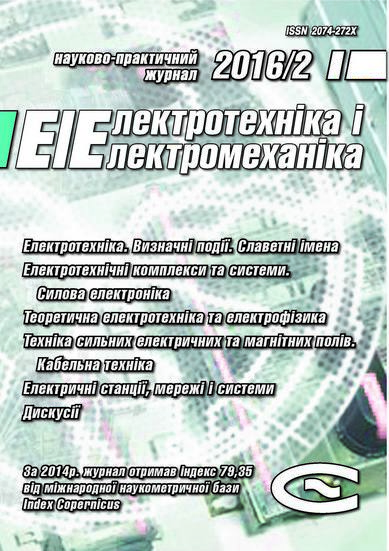LOW-FREQUENCY MAGNETIC FIELD SHIELDING BY A CIRCULAR PASSIVE LOOP AND CLOSED SHELLS
DOI:
https://doi.org/10.20998/2074-272X.2016.2.03Keywords:
shielding factor, magnetic field, circular passive loop, thin shellAbstract
Purpose. To analyze the shielding factors for a circular passive loop and conductive closed shells placed in a homogeneous low-frequency magnetic field. Methodology. We have obtained simplified expressions for the shielding factors for a circular passive loop and a thin spherical shell. In addition, we have developed the numerical model of a thin cubical shell in a magnetic field, which allows exploring its shielding characteristics. Results. We have obtained dependences of the shielding factors for passive loops and shells on the frequency of the external field. Analytically determined frequency of the external magnetic field, below which field shielding of a passive loop is expedient to use, above which it is advisable to use a shielding shell.
References
1. International Commission on Non-Ionizing Radiation Protection. ICNIRP Guidelines for limiting exposure to time-varying electric and magnetic fields (1 Hz-100 kHz). Health Physics, 2010, vol.99, no.6, pp. 818-836. doi: 10.1097/HP.0b013e3181f06c86.
2. Korol’ E.G., Pantelyat M.G. EMC requirements of technical devices at electric power facilities and industrial. Visnyk NTU «KhPI» – Bulletin of NTU «KhPI», 2013, no.15, pp. 35-60. (Rus).
3. Rozov V.Yu. Assuirov D.A. Method of the active shielding of technical objects external magnetic field. Tekhnichna elektrodynamika – Technical electrodynamics, 2006, no.3, pp. 13-16. (Rus).
4. Kuznetsov B.I., Nikitina T.B., Bovdui I.V., Voloshko A.V., Vinichenko E.V., Kotliarov D.A. Active screening of magnetic field near power station generator buses. Elektrotekhnіka і elektromekhanіka – Electrical engineering & electromechanics, 2013, no.6, pp. 66-71. (Rus).
5. Kaden H. Wirbelströme und Schirmung in der Nachrichtentechnik. – Springer Berlin Heidelberg, 1959. doi: 10.1007/978-3-540-32570-3.
6. Buccella C., Feliziani M., Maradei F., Manzi G. Magnetic field computation in a physically large domain with thin metallic shields. IEEE Transactions on Magnetics, 2005, vol.41, no.5, pp. 1708-1711. doi: 10.1109/TMAG.2005.846059.
7. Kistenmacher P., Schwab A. Low-frequency shielding effectiveness of inhomogeneous enclosures. Proceedings of IEEE International Symposium on Electromagnetic Compatibility, 1996, pp. 347-352. doi: 10.1109/ISEMC.1996.561256.
8. Clairmont B.A., Lordan R.J. 3-D modeling of thin conductive sheets for magnetic field shielding: calculations and measurements. IEEE Transactions on Power Delivery, 1999, vol.14, no.4, pp. 1382-1393. doi: 10.1109/PESW.1999.747382.
9. Roginskiy V.Yu. Ekranirovanie v radioustroystvah [Shielding in radio devices]. Leningrad, Energiya Publ., 1969. 112 p. (Rus).
10. Grinchenko V.S., Chunikhin K.V. Shielding of a uniform alternating magnetic field using a circular passive loop. Elektrotekhnіka і elektromekhanіka – Electrical engineering & electromechanics, 2015, no.2, pp. 31-34. (Rus).
Downloads
Published
How to Cite
Issue
Section
License
Copyright (c) 2016 V. S. Grinchenko, K. V. Chunikhin, N. V. Grinchenko

This work is licensed under a Creative Commons Attribution-NonCommercial 4.0 International License.
Authors who publish with this journal agree to the following terms:
1. Authors retain copyright and grant the journal right of first publication with the work simultaneously licensed under a Creative Commons Attribution License that allows others to share the work with an acknowledgement of the work's authorship and initial publication in this journal.
2. Authors are able to enter into separate, additional contractual arrangements for the non-exclusive distribution of the journal's published version of the work (e.g., post it to an institutional repository or publish it in a book), with an acknowledgement of its initial publication in this journal.
3. Authors are permitted and encouraged to post their work online (e.g., in institutional repositories or on their website) prior to and during the submission process, as it can lead to productive exchanges, as well as earlier and greater citation of published work.





